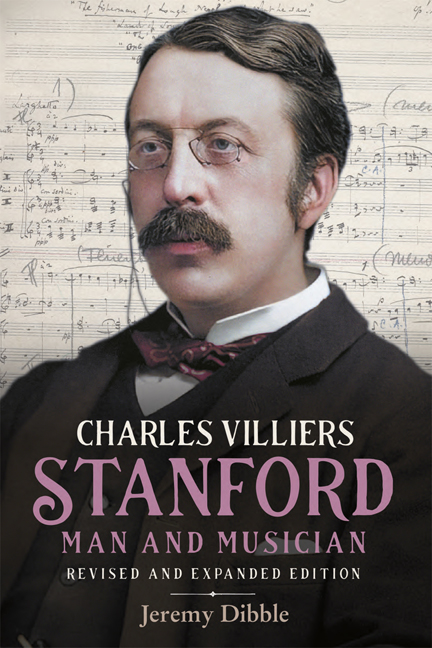Book contents
- Frontmatter
- Dedication
- Contents
- List of Illustrations
- List of Music Examples
- List of Analytical Tables
- Preface and Acknowledgements
- Supplementary Introduction to the Revised and Expanded Edition
- List of Sigla and Abbreviations
- I Early Influences and Impressions, 1852–70
- II Formative Years, 1870–87
- III Recognition, 1888–1901
- IV The New Generation, 1901–14
- V War and Decline, 1914–24
- Appendix: List of Works
- Select Bibliography
- Index of Works
- General Index
- Irish Musical Studies Previous volumes
2 - Childhood: Dublin in the 1850s and 1860s
Published online by Cambridge University Press: 12 May 2024
- Frontmatter
- Dedication
- Contents
- List of Illustrations
- List of Music Examples
- List of Analytical Tables
- Preface and Acknowledgements
- Supplementary Introduction to the Revised and Expanded Edition
- List of Sigla and Abbreviations
- I Early Influences and Impressions, 1852–70
- II Formative Years, 1870–87
- III Recognition, 1888–1901
- IV The New Generation, 1901–14
- V War and Decline, 1914–24
- Appendix: List of Works
- Select Bibliography
- Index of Works
- General Index
- Irish Musical Studies Previous volumes
Summary
During the first half of the nineteenth century, Dublin's musical life had experienced a decline, though as Brian Boydell has demonstrated, this was not due initially to the Act of Union. In fact it was only in the aftermath of the Napoleonic Wars and agricultural depression in the 1820s that the dissolution of Dublin as a social centre began to occur as many of the aristocracy and landed gentry turned their attention towards London. The inevitable effect of this shift in focus was, however, to signal a corresponding decline in public interest and patronage, the former of which only beginning to re-awaken as the new ‘professional aristocracy’ used their own increasing prosperity to encourage the arts. That over twenty new music societies came into being between 1840 and the end of the 1860s is demonstrative of this new momentum, and judging from the notices in the mid-century issues of Freeman's Journal and Saunders News Letter, music-making in Dublin certainly equalled that of its pre-Union days and possibly even exceeded it . Among the more significant of these societies were the Dublin Mechanics’ Choral Society (1850), the Royal Choral Institute (1851), the Dublin Mercantile Choral Union (1854) and the Amateur Musical Society (founded by George Lee in 1852). Mindful of the private nature of other musical societies, these bodies attempted to reach out to the working classes in order to introduce them to the great choral works of the eighteenth and nineteenth centuries. In this venture they were largely successful. John William Glover, organist of St Mary's Pro-Cathedral and founder of the Royal Choral Institute gave performances of Handel's Samson, Messiah¸ Alexander's Feast and Jephtha, Haydn's Creation, Mendelssohn's Elijah and, more entrepreneurially, Schumann's Paradise and the Peri (its first hearing in Ireland in 1854). It was the maturer organisations, however, such as the Philharmonic Society (the successor to the Anacreontic Society) and the Antient Concert Society, founded in 1826 and 1834 respectively, that played a major role in the city's musical life. The Antient Concert Society endeavoured to produce an average of five choral concerts during the season, and under Robinson's direction became a focal point of Dublin's musical life. As a distinguishing feature, the Philharmonic concerts tended to place emphasis on orchestral works and were modestly successful in attracting virtuosi such as Thalberg, Hallé, Joachim and Rubinstein to play concertos for them. The quality of performances was, however, distinctly variable; the orchestra was entirely amateur in constitution and the rough quality of sound was not enhanced by its less than competent conductor Henry Bussell, a parochial organist ‘who was a kindly Englishman of exceptional stodginess, scarcely knew one end of the stick from the other, and was certainly incapable of reading a score to any advantage either to himself or to his myrmidons’. Nevertheless, Bussell did manage to undertake the first performance in Ireland of Beethoven's Ninth Symphony in 1856 which elicited approbation from the press. The Antient Concerts and those for the Philharmonic were essentially the preserve of the wealthier Protestant classes. Confined to members and their guests, their concerts were formal occasions requiring evening dress and thereby carried an air of social caché.
- Type
- Chapter
- Information
- Charles Villiers StanfordMan and Musician, pp. 20 - 46Publisher: Boydell & BrewerPrint publication year: 2024



